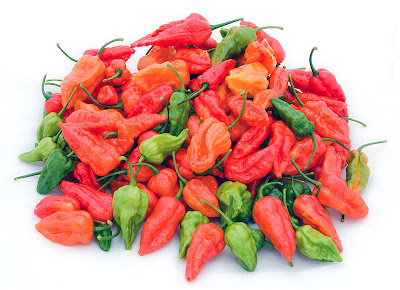Short URL for the story: http://goo.gl/9EGXF
A molecular study carried out by Indian defense researchers
indicates that molecular characters and the unique ecological environment of North
East India make Bhut Jolokia distinct from other closely related chilli species
and keep it world’s hottest. Locally known as “Bhut Jolokia”, this pepper
variety found in the North Eastern parts of India and is considered as the
hottest chilli in the world.
 |
| Bhut Jolokia, worlds hottest chilli Image Courtesy: Xaime Méndez (Wikimedia Commons) |
According to the study published in the latest issue of the
Journal of Biosciences a phylogenetic analysis of the ribosomal RNA sequence of
the chilli indicates that specific sequences from all Bhut Jolokia fruits
collected from different parts of the country exhibited a distinct clade or
common ancestors than the related species.
Moreover, a 13 base deletion was also found in the
representative sequencing of Bhut Jolokia. This peculiarity makes it different
from all other members of the Capsicum genus, according to the study. “A unique
13-base deletion was observed in all the representative accessions of Bhut
Jolokia, making it distinct from all other members within the genus and beyond”,
says the study.
Debate on species status
Despite its unique pungency, taxonomists have always debated
on considering it as a separate species. Many scholars consider it as just a
variety of Capsicum frutescens. Guinness
Book of World Records, which in 2006, has acknowledged it as the hottest
pepper, however, has recorded it as a variety of Capsicum chinese. Later a group of researchers have found that the
plant actually stands between the two varieties, being a hybrid of the two.
The new finding made by the researchers at the Defense
Research laboratory, Defense Research and Development Organization (DRDO) and Defense
Research & Development Establishment (DRDE) supports the arguments to
consider Bhut Jolokia as a separate species of hot chilli.
Ecological environment influence on Capsaicin presence
 |
| Bhut Jolokia on the plant Image Courtesy : Wikimedia Commons |
The study has also pointed out that the extreme pungency of
the chilli variety may have been influenced by the peculiar environmental
factors present in the North Eastern parts of the country. According to it,
high average temperature in the atmosphere and draught like situations may
increase the pungency of the pepper, apart from genetic factors.
When the researchers have analyzed the presence of Capsaicin,
the element which gives pungency to the pepper and is the base for the Scoville
ratings, it was found that Bhut Jolokia grown in Gwalior in Madhya Pradesh had
50 percent less Capsaicin, which makes it 50 percent less hotter than the fruit
from the same species plant grown up in Tezpur in Assam. According to the researchers,
this explains how the hot and humid climate in the North East India is making Bhut
Jolokia hottest among the chillies.
Hottest Chilli in the world
Bhut Jolokia has grabbed the title ‘world’s hottest
chilli’ from the Red Savina Habanero found in Canada, when it was found that
Jolokia is at least two times hotter than it in terms of Scoville Heat units
which is the measurement of hotness in chillies.
Interestingly, the name Bhut Jolokia hints a ghostly bite,
which actually leaves the victim burning for at least 30 minutes without
subsiding. It is being used by local people for a variety of purposes like
making spicy food, to prepare medicines and even in smoke bombs to keep wild
elephants away.

No comments:
Post a Comment
Please feel free to have your say on our stories. Comments will be moderated. anonymous Comments will not be approved. No links in the comment body unless meant for sharing a very relevant info.